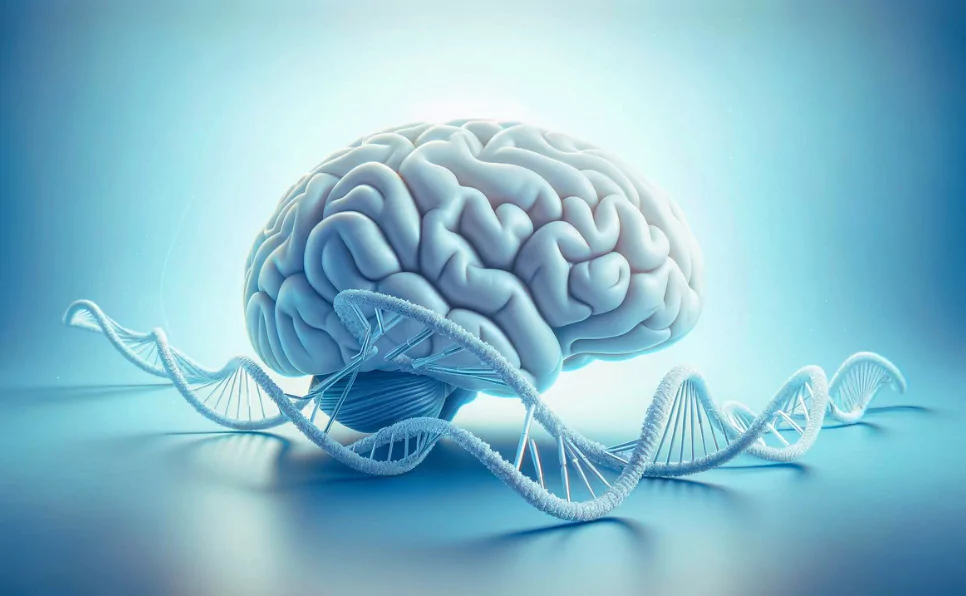Lactose tolerance and intolerance tell a fascinating story about human evolution, particularly how our diets have shaped our genetics over thousands of years.
Understanding this aspect of human biology is a window into our past that explains a lot about modern dietary habits and health issues.
Lactose tolerance isn’t just about whether you can enjoy a glass of milk without discomfort; it’s a testament to human adaptation and survival.
In this article, we will discuss how genetics and environment such as availability of diary interact with each other and influence our eating habits.
Lactose Persistence and Intolerance
Lactose is a type of sugar found in milk and dairy products. For our bodies to use this sugar, it needs to be broken down into simpler sugars, glucose and galactose, by an enzyme called lactase.
This process happens in the small intestine.
But here’s the twist: not all adults produce enough lactase to effectively digest lactose, leading to lactose intolerance.
Symptoms can include bloating, gas, and diarrhea, which, let’s be honest, no one enjoys.
“The ability to digest lactose into adulthood is a unique human adaptation not shared with many other mammals.”
Genetic Basis of Lactose Persistence/Tolerance
At the heart of lactose tolerance is the lactase persistence gene.
This gene tells your body to keep making lactase throughout life. Whether you have this gene variant largely depends on your ancestry.
It’s like a genetic lottery ticket that has been influenced by our ancestors’ dietary habits.
The LCT gene, responsible for producing the enzyme LPH, is found on chromosome 2q21 and controls the ability to digest lactose.
While most humans and mammals experience a decrease in LCT gene activity after infancy, leading to lactose intolerance (LNP), some adults maintain high LCT expression and can digest lactose (LP).
This difference is due to genetic variations near the LCT gene, particularly within the MCM6 gene’s intron, influencing LCT’s activity in response to age and diet.
The -13910C variant commonly leads to lactose intolerance, while the -13910T variant allows for lactose tolerance, with the degree of tolerance affected by whether a person has one or two copies of these variants.
Genetics play a crucial role in determining lactose tolerance, making it a clear example of how our environment can shape our biology.
The Evolutionary Story of Lactose Tolerance
Lactose Tolerance in Ancient Populations
Our ancestors weren’t born with the ability to digest lactose.
This trait evolved around 7,500 years ago, coinciding with the domestication of dairy animals.
Archaeological findings show that ancient populations in Europe, Africa, and the Middle East started to show signs of lactose tolerance as they incorporated dairy into their diets.
It’s a classic case of what scientists call gene-culture co-evolution: our cultural practices (like dairy farming) directly influenced our genetic makeup.
- Dairy farming became a nutritional game-changer, providing a reliable food source that likely gave lactose-tolerant individuals a survival advantage.
Geographic Variation in Lactose Tolerance
The prevalence of lactose tolerance is a patchwork across the globe.
It’s most common in populations with a long history of dairy farming, such as in northern Europe, and less common in regions where dairy farming was adopted later or not at all, like East Asia.
This geographic variation is not random but tells a story of migration, adaptation, and the spread of agricultural practices.
In some regions, over 90% of the population can digest lactose.
Theories explaining this distribution often come down to natural selection. In places where dairy was a key part of the diet, being lactose tolerant was a major advantage.
This trait was passed down through generations, becoming more common in those populations.
Lactose Tolerance and Human Health
Lactose tolerance isn’t just a random genetic quirk; it’s a fascinating glimpse into human adaptation and evolution.
Benefits of Lactose Tolerance
Being able to digest lactose, the sugar found in milk and dairy products, is a superpower, at least from a nutritional standpoint. Here’s why:
- Milk is packed with essential nutrients. It’s a rich source of calcium, vitamin D, potassium, and protein. For lactose-tolerant individuals, consuming dairy is an easy way to intake these crucial nutrients.
- Dairy has played a key role in human diets for millennia. Archaeological evidence shows that as humans transitioned from hunter-gatherers to farmers, dairy animals became a vital part of our ancestors’ livelihoods and nutrition.
“Milk isn’t just food; it’s a bridge to our past, a link to our ancestors who first braved the wild aurochs and learned to live alongside them.”
Managing Lactose Intolerance
But what if you’re among the many who experience discomfort from dairy? Here’s the good news:
- Lactose intolerance isn’t the end of the road for dairy. There are lactose-free milk and dairy products, as well as lactase supplements that make digestion easier.
- Plant-based alternatives are on the rise. Almond, soy, oat, and coconut milks are not only lactose-free but also rich in vitamins and minerals. However, it’s important to choose fortified versions to match the nutritional benefits of dairy.
In a world where food is constantly evolving, lactose intolerance has become less of a limitation and more of a dietary preference.
The Cultural Impact of Lactose Tolerance
Dairy products are not just foods; they’re cultural symbols, deeply intertwined with traditions, rituals, and economies across the globe.
Dairy in Human Cultures
- Dairy’s significance varies widely across cultures. In some societies, milk and cheese are staples, celebrated in festivals and used in religious rites. In others, dairy is less central, either due to genetic lactose intolerance rates or environmental factors.
- Lactose tolerance has shaped entire cuisines. Think of the rich, creamy sauces of French cuisine or the plethora of cheese varieties in Italy. These culinary traditions owe a lot to the genetic lottery of lactose tolerance.
Lactose Tolerance and Social Dynamics
- Historically, lactose tolerance had economic and social implications. Communities with high rates of lactose tolerance could exploit dairy farming, giving them a nutritional and economic edge.
- This genetic trait influenced societal structures. In some cultures, owning dairy animals and consuming their products became markers of wealth and status.
“Lactose tolerance didn’t just shape our diets; it helped mold the societies we live in today.”
Scientific Advances and Future Directions
With the advent of modern genetics, our understanding of lactose tolerance has grown exponentially. We’re not just looking back at how it shaped our past; we’re looking forward to how it can inform our future.
Genetic Testing for Lactose Tolerance
- Genetic testing offers personal insights. Today, a simple test can reveal your lactose tolerance status, providing a clearer picture of your dietary needs and health.
- This knowledge is empowering. Knowing whether you’re lactose tolerant can help tailor your diet to your genetic makeup, potentially improving your well-being.
The Future of Dairy Consumption
- Trends in dairy consumption are shifting. As awareness of lactose intolerance spreads, demand for lactose-free and plant-based alternatives is rising.
- The dairy industry is adapting. From genetically modified cows that produce lactose-free milk to innovations in plant-based dairy, the future looks inclusive.
Final Thoughts
Lactose tolerance is more than a matter of digestive comfort; it’s a window into our past, present, and future.
As we continue to unravel the genetic threads of this trait, we not only gain insights into human evolution but also pave the way for a more inclusive understanding of diet and health.
The journey of lactose tolerance is the journey of human adaptability and innovation, reminding us that our relationship with food is as complex as it is vital.
FAQs
Can lactose intolerance develop later in life?
Yes, it’s quite common for individuals to develop lactose intolerance as they get older, a phenomenon known as lactase non-persistence. This occurs because the body produces less lactase, the enzyme needed to digest lactose, leading to symptoms when dairy products are consumed.
Are there any health risks associated with lactose intolerance?
While lactose intolerance itself isn’t harmful, it can lead to nutritional deficiencies if dairy is completely eliminated without finding alternative sources of calcium, vitamin D, and protein. It’s crucial to balance the diet to avoid such deficiencies.
Is lactose intolerance the same worldwide?
No, lactose intolerance rates vary significantly across different populations. Factors like genetics, diet, and evolutionary history influence how common lactose intolerance is in a given region, with some groups showing high tolerance due to their ancestral dietary practices.
Can lifestyle or diet influence lactose tolerance?
Lifestyle and diet don’t alter the genetic aspect of lactose tolerance but can impact how the body responds to lactose. For example, gradually introducing small amounts of dairy or utilizing probiotics can sometimes help manage symptoms more effectively.
For Further Reading:
- The evolutionary tale of lactase persistence in humans – Nature Review Genetics
- Evolution of lactose tolerance probably driven by famine and disease – New Scientist
- Dairying, diseases and the evolution of lactase persistence in Europe – Nature
- Genetics of Lactose Intolerance: An Updated Review – Nutrients
- Famine and disease drove the evolution of lactose tolerance in Europe – Ucl
- Milk Tolerance Evolved More Than Once – ANN
- On the Evolution of Lactase Persistence in Humans – Annual Reviews

Dr. Sumeet is a seasoned geneticist turned wellness educator and successful financial blogger. GenesWellness.com, leverages his rich academic background and passion for sharing knowledge online to demystify the role of genetics in wellness. His work is globally published and he is quoted on top health platforms like Medical News Today, Healthline, MDLinx, Verywell Mind, NCOA, and more. Using his unique mix of genetics expertise and digital fluency, Dr. Sumeet inspires readers toward healthier, more informed lifestyles.





